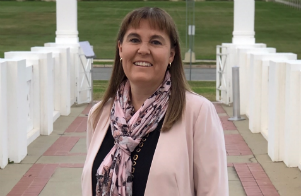Mobilised communities driving rural and regional transformation

Mobilised communities driving rural and regional transformation

Marnie Baker, Managing Director Bendigo and Adelaide Bank’s address at the Regional Australia Institute’s
Regions Rising Event Series in Canberra on 4 April 2019
Let me tell you a story about the small community of Warburton in Victoria’s Yarra Ranges, where one day about ten years ago, two men were playing golf on the steep local course which has the picturesque and ever flowing Ythan river running through it.
These two golfers had an idea, what if they could restore the town’s old hydro scheme. It had operated a hundred years ago and supplied electricity to the community before the town was connected to the energy grid. If they could get it up and running again, they thought it could provide their town with a consistent renewable energy option and a return of sustainable profits to the community.
Ten years and $1.2 million later the Warburton Community turned on its own Hydro Power Plant, capable of powering the equivalent of 150 homes (Bendigo Bank, 2019). The majority of profits generated from the new system are returned to important community initiatives.
It’s an example of a community determined to achieve valued self-reliance and to have the ability for it to generate its own income and help determine its future. The project shows what can happen when community, business and government combine for the greater good.
Now that’s just one community, picture what could happen if this was occurring right across Australia. Well, I can let you in on a secret it already is.
I’m Marnie Baker and I’m the Managing Director of Bendigo and Adelaide Bank. I’ve always lived and worked in rural and regional Australia. I grew up in Cohuna – a small town in Northern Victoria on the Murray - and I‘ve spent my adult life living on the outskirts of Bendigo.
There are a few things I know about country people. We’re resilient, we’re clever and we have a strong sense of community. We also face a number of key challenges that our friends in the city don’t – or at least don’t experience as severely.
There’s Mother Nature and all that she throws at us, but then there’s the man-made problem of equity. Equity in accessing funding, health care, education, transport, infrastructure and technology to name a few.
We also don’t like a hand out – we’d much prefer a hand up. Throughout my time at Bendigo and Adelaide Bank, I’ve had the privilege of offering our customers and the communities they live and work in a hand up. Primarily by helping them to finance their homes, farms and businesses, but also by playing a role in empowering them to take control of their community’s economic security, which has led to amazing social outcomes.
This flips the dominant narrative about the plight of helpless and declining rural communities, and it shines a light on inspiring stories of empowerment, revival, renewal and world-leading innovation.
Today we have gathered people from all walks of life – politics, government, business, not-for-profits, academia and community leaders. We are all here for one reason – to make rural and regional Australia the best it can be.
We want to send a message that the whole country can enjoy the benefits of prosperity, not just a handful of rich regions. A rising tide does not necessarily lift all boats – it needs the right strategy and collective effort. The path to achieving this goal will require collaboration. I will talk about the role each of us needs to play in this collective effort for long-term success, and the things we can do now to achieve better outcomes in the short-term.
I’d like to start by telling you a bit about the bank I lead. Our organisation was established in Bendigo during the 1850’s gold rush. Our belief then, as it is now, is that the purpose of our Bank is to feed into the prosperity of our customers and communities – not off it.
Just pause for a moment and ponder that proposition, as it’s a very simple rule that we believe should govern the thoughts, deeds and actions of not only our business but all businesses. Again, our purpose is to feed into prosperity - not off it.
Yet, as consumers we know that many businesses pay lip service to this ethos. Last year, the Edelman Trust Barometer showed that trust in Australia fell to an all-time low (Edelman, 2018). It’s up a little in the latest results, however when we look at Australian government, NGOs, business and media as a collective group, Australians continue to have little faith in these institutions. Our country recorded an average trust level of just 48 percent (Edelman, 2019).
We Aussies have always been an optimistic lot, but the world has changed, and our attitudes have shifted. Among the most distrusted industries, is banking and finance (Edelman, 2019) and we don’t have to look much further than the Financial Services Royal Commission into misconduct to see why.
You won’t have seen Bendigo Bank splashed over the front page of the newspapers for impropriety, that’s because for more than 160 years we’ve done business differently. We’ve focused on the interests of our customers and meeting community expectations. We know when you focus on creating win/win deals – not win/lose deals – great things can happen.
According to Edelman’s recent research, some 72 per cent of Australians agree, they want to see businesses increase their profits and simultaneously improve their communities-this is up 9 per cent and in-line with a global trend (Edelman, 2019).
Our Bank is a Shared Value business, that is one that’s designed to respond to a social problem while meeting business objectives, thus creating a win for business and society alike (Porter and Kramer, 2011). Our most famous iteration of this is Community Banking, where we partner with communities to deliver banking services and socioeconomic outcomes. More recently we’ve worked with universities and credit unions to adapt the model. Some of these partners are here with us today, and I’m sure they’d be happy to share their experience of our Shared Value partnership with you.
Displayed are a few facts and stats about our Bank. The thing I’m most proud of are the results we’ve achieved relating to satisfaction and trust, as these indicate people love what we do and how we do it, and they reward us with the most valuable asset of all – their trust. How do we do it? Well it’s pretty simple, we walk the talk.
One of the clearest displays of this can be seen in the heart of Bendigo where our headquarters is based. It’s an important statement that speaks volumes about our investment in and commitment to rural and regional Australia. It’s worth noting our Bank is the only one that has its headquarters outside of a capital city, and more than half of our branches are also in rural or regional settings. Not only does our Bank have its roots in regional Australia, we also exist within hundreds of rural and regional communities.
The trust, good will and genuine connection we’ve established with Australian communities, has been strongly influenced by our Community Bank® initiative which has been a profound enabler of prosperity in rural and regional Australia.
The unique community-led solution was developed in 1998, after a number of Australian banks withdrew their branch services (Bendigo Bank, 2019). Closures often targeted smaller, country communities and had a significant impact on the economic prosperity of these towns. We know that when a bank branch closes, it often prompts the departure of other services and businesses from the town, which then further exacerbates population decline (Altman and Taylor, 2004).
But resilient, clever, community-minded regional Australians put a stop to this trend and worked with our Bank to develop the Community Bank® - the original Shared Value business model. The partnership sees Bendigo Bank form a franchise agreement with a community that has displayed it’s capable of owning and operating a bank branch. Once the Community Bank® is operating and profitable the revenue made from the banking business is shared equally between Bendigo Bank and the community. The Community Bank® board, which is made up of local volunteer leaders, then distribute earnings to local shareholders and invest capital into local initiatives.
Community Banking has more than exceeded its original purpose and does far more than simply restore or provide more competitive banking services. Community Bank® companies create an alternative and sustainable source of income communities can use to fund - and if they are able, leverage funding for - the initiatives and activities they choose.
In 20 years, we’ve opened just over 320 branches and communities continue to want to partner with us and for good reason – with many more in discussion with us as we speak (Bendigo Bank, 2019). Since its inception Community Banking has generated $205 million for reinvestment in communities (Bendigo Bank, 2019). This money has been spent addressing local needs, desires and aspirations as chosen by the community. Let’s also remember the profits are retained in local communities and are not shipped back to Sydney or Melbourne.
Community Banking has a long history of fully funding or providing seed funding for major projects worth millions of dollars. Communities often use Community Bank® capital to attract investment from other stakeholders including government. Last year, more than $22 million was invested into community projects, but this investment was more than doubled through leveraged funding, with the total spend closer to $58 million (Bendigo Bank, 2019).
Displayed are some of the top community projects in rural and regional areas from 2018. The top 20 Community Bank® initiatives from the past two years, have managed to turn one dollar into ten - transforming $9 million in community - capital into $90 million worth of community assets (Bendigo Bank, 2019).
Community Bank® companies also meet shortfalls in community funding, providing things like football jumpers for the footy team, change rooms for the women’s tennis club or tools for the local Men’s Shed. These are the little things that make regional and rural towns more liveable places, which in turn helps them to attract people, businesses and industries to their community. And isn’t that why we are all here today?
Community Bank® companies play an important role in strengthening and diversifying the local economy, as they create new public companies and often in communities that have never had one. They provide new ways for local people to become shareholders so they can invest and grow their personal prosperity, while supporting a truly local community enterprise. The branches also create new local jobs, helping to address issues associated with growing and sustaining population in regional and rural areas.
Almost 1,600 people are employed by Community Bank® branches nation-wide, and about $92 million was paid in salaries last year (Bendigo Bank, 2019). These are new jobs, often in a new industry that brings a more diverse skill set to a town. The flow on economic impact is significant. Last year, the total business expenses paid back into local communities was around $137 million - a major injection of capital back into local economies that simply wouldn’t exist without Community Banking (Bendigo Bank, 2019).
Community Banking builds local leadership capacity and governance practices through the formation of boards, which are comprised of local directors. More than 1,900 directors volunteer an average seven hours a week to ensure the successful running of their local company (Bendigo Bank, 2019). Importantly, many of these people use and share the transferable skills they acquire by serving on a Community Bank® board at other local businesses and organisations.
At first, Community Bank® companies filled the economic and social void left following the closure of major bank branches in rural areas. Now, you’ll find Community Bank®branches in cities, suburbs and regional hubs across Australia. The driving ambition of every Community Bank® company is to make local investments which enhance and grow community capital. One of the key ways they achieve this is by facilitating grass roots community planning, whereby the community can determine, prioritise and fund shared objectives.
Community Banking is just one way our Bank partners with rural and regional communities, yet it is probably the space where our organisation has developed the most expertise in what communities really need to be successful. From our experience, we see the key to creating a strong socioeconomic environment is striking the right mix of skilled people, connecting and empowering them, and ensuring they have access to the capital required to build communities. However, we know even more could be achieved if a greater focus was placed on supporting mobilised communities by reducing complexity and streamlining the ways they access funding.
The Community Banking legacy is one of mobilised communities that are empowered to determine their own social and economic destiny. And successful and prosperous communities are far more attractive places to live, work and do business.
They’re also great environments for government to operate in, as government can partner with communities to get great results, quicker and more efficiently. The communities we partner with understand and identify local need, work with the community to design a solution, and offer a collaborative solution government can be a part of.
A mobilised community is one that can understand, identify and do. So how do we supercharge these mobilised communities? It’s pretty easy, and it starts by stepping aside and getting out of their way, but in doing so offering that hand up. Each of us - be us from business, government or not-for-profit - can extend that hand, and there are three key ways we do this.
First, reduce complexity and make it easy. The communities we partner with tell us government needs to reduce complexity and streamline funding pathways. They would love to work with government to build a simple and consistent approach across the three tiers, so that it’s easy for community to partner at a local, state and federal level. A simplified process would also make it easier to include other funding partners (both for profit and not for profit) in the mix. There’s also a strong sense that great initiatives shouldn’t succeed or fail based on a community’s ability to fill in a grant application.
Second, encourage collaboration, not competition. Competition for grants shouldn’t pit neighbouring communities against each other, rather it should encourage them to seek out shared opportunities and collaborate. When these sorts of barriers are successfully navigated, incredible things can be achieved for entire regions – not just one community.
And third, remember the little guys. Smaller communities are often at a disadvantage when it comes to competing for grant programs that are focused on economic development. Yet strong evidence exists to show that small communities are pragmatic and resourceful – they extract maximum value from relatively small investments and are proactive in maintaining community assets. Amenity and public realm investments in smaller communities have a significant positive impact in boosting civic pride and resilience, particularly where local services and facilities have either been lost or are under pressure to remain viable.
In conclusion, I want us to imagine what we could collectively achieve if we worked alongside empowered communities – of which we know there are many - to tackle the complex and diverse set of challenges facing rural and regional Australia. Positive, profound and lasting change is possible – a visit to almost any Community Banking town or region will show you that.
At Bendigo and Adelaide Bank we know that successful customers, create successful communities, which leads to a successful bank, and only in that order. The simple act of banking – something we all do – can and should if administered correctly have a positive impact on Australian communities. But this is only possible if that bank has a genuine belief that its purpose is to feed into prosperity – not off it. I’d like you to ask yourself, whether your financial institution is doing this? If you don’t like the answer and want to be part of what we do, then let’s talk.
This is an exciting time to be a rural and regional Australian, and we all have an important role to play in shaping what happens next. The efforts we make today to strengthen and improve our communities and regions, will transform all of Australia for decades to come.
References
Altman, JC, Taylor, J, “Money Matters in the Bush: Inquiry into the Level of Banking and Financial Services in Rural, Regional and Remote Areas of Australia”, Parliamentary Joint Committee on Corporations and Financial Services, Vol. 3, No.3, January 2004, pp. 27-43.
Bendigo Bank 2019, accessed 11 March 2019, https://www.bendigobank.com.au/community
Edelman 2018, accessed 11 March 2019, https://www.edelman.com/research/2018-edelman-trust-barometer
Edelman 2019, accessed 11 March 2019
Porter, ME and Kramer, MR, “Creating Shared Value,” Harvard Business Review, Vol. 89, No. 1, 2011, pp. 2-17.





